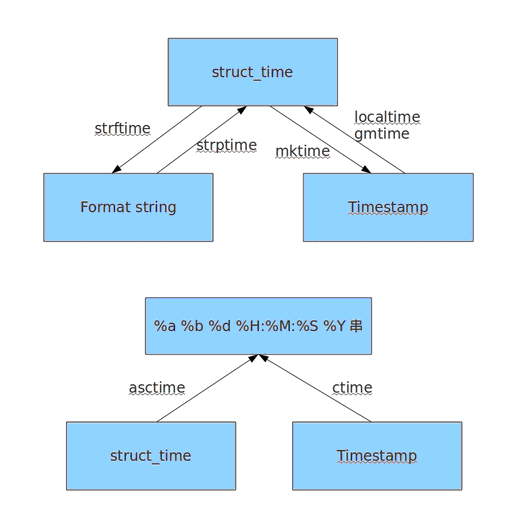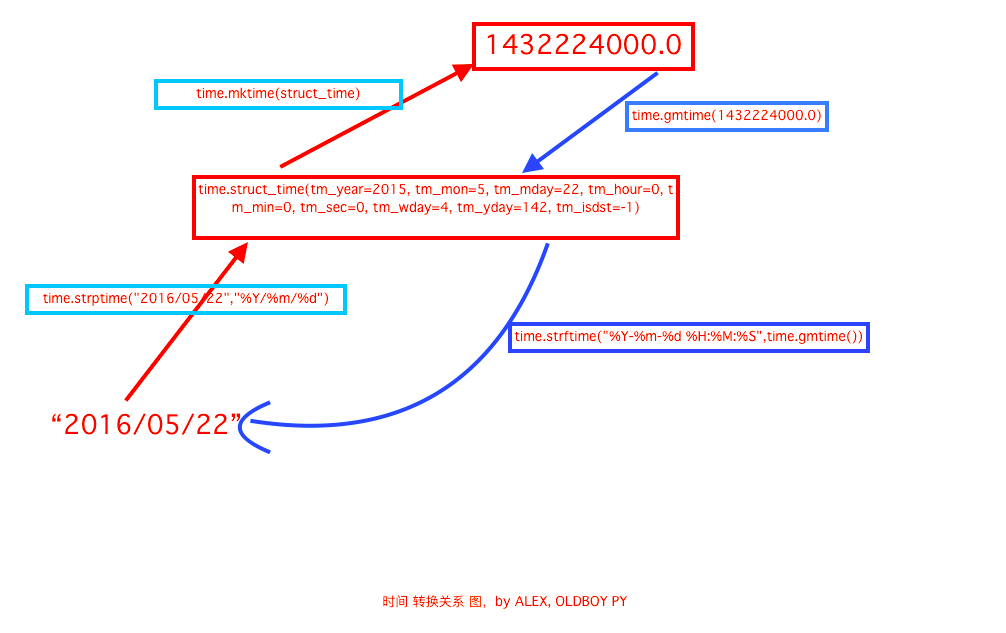python模块概况,json/pickle,time/datetime,logging
参考:
http://www.cnblogs.com/wupeiqi/articles/5501365.html
http://www.cnblogs.com/alex3714/articles/5161349.html
1、模块的分类
内置模块:存放在lib目录下
第三方模块:通常放到site-packages目录下
自定义模块:可以通过sys.path.append(module_path)添加模块到搜索路径
2、 模块的调用顺序
按path列表从前到后的顺序按模块名搜索模块。一定避免模块重名,不要和内置模块重名。
import sys
for i in sys.path:
print(i)
打印结果类似下面:
/usr/local/lib/python35.zip
/usr/local/lib/python3.5
/usr/local/lib/python3.5/plat-linux
/usr/local/lib/python3.5/lib-dynload
/root/.local/lib/python3.5/site-packages
/usr/local/lib/python3.5/site-packages
3、导入模块的几种方法
import module 导入同级目录下的单模块
from module.xx.xx import xx 导入嵌套在文件夹下的模块
from module.xx.xx import xx as rename as后面是模块的别名
from module.xx.xx import *
4、安装第三方包
python3自带pip模块,因此可以使用 pip install <package name> 安装第三方包
也可以使用源码安装。去官网 https://pypi.org/ 搜索你要下载的包,解压后,转到安装包目录下,运行 python setup.py install
5、json/pickle模块,序列化与反序列化
json.dumps(data) 将基本数据类型转换为字符串
json.loads(str) 将字符串转换为基本数据类型。注意:通过loads反序列化时,一定要用双引号把字符串括起来(因为在其他程序语言中,字符串是用双引号括起来的)
json.dump(data,open('file','w')) 将基本数据类型转换为字符串,并将其写入文件file
json.load(open('file','r')) 从文件file读字符串,将字符串转换为python基本数据类型
dic = {1:'a',2:'b'}
print(dic,type(dic)) #{1:'a',2:'b'}, class 'dict'
res = json.dumps(dic) #将字典dic转换为字符串res
print(res,type(res)) # "{1:'a',2:'b'}" class 'str'
li = '[1,2,"kaye"]' # 内层用双引号,外层用单引号,否则会报错!!
print(li,type(li)) #'[1,2,"kaye"]', class 'str'
res = json.loads(li) #将字符串li转换为列表res
print(res, type(res)) #[1,2,"kaye"], class 'list'
requests.get()方法从API获取字符串,用json.loads()把字符串转换为python基本数据类型。代码如下:
import requests
import json res = requests.get('http://wthrcdn.etouch.cn/weather_minni?city=北京')
requests.encoding = 'utf-8'
dic = json.loads(res.text)
print(dic,type(dic))
pickle.dumps(data) 将python对象转换为字符串
pickle.loads(str) 将文件内容转换为python对象
pickle.dump(data,open('file','wb')) 将python对象转换为字符串,并将其写入文件file,一定要加b(表示以二进制存储到文件),不然会报错
pickle.load(str,open('file','r')) 从文件file读字符串,将文件内容转换为python对象
json VS pickle
json模块可以支持跨语言的基本数据类型(支持python,c#,php.....等多种语言,但是只支持基本数据类型包括列表、字典、元组等等)
pickle模块可以对复杂类型做操作,比如对象,但是不能支持python以外的其他语言
6、time/datetime模块
import time print(time.time()) # 返回当前时间戳(从1970年1月1日开始计时到现在,一共有多少秒)
print(time.ctime()) # 返回当前时间,可读性更好
print(time.gmtime()) # 获得格林威治时间(UTC时间)的struct_time模式(时间对象),该对象属性包括tm_yaer,tm_mon,tm_mday,tm_hour,tm_min,tm_sec,tm_wday,tm_yday,tm_isdst
print(time.localtime()) # 和gmtime类似,但返回的是本地时间
print(time.mktime()) # 将stuct_time格式转换为时间戳
print(time.sleep()) # 程序在这里睡眠/延迟,用于处理阻塞
print(time.strftime()) # 将stuct_time格式转换为指定的字符串格式,eg. time.strftime("%Y-%m-%d %H:%M:%S")
print(time.strptime()) # 将字符串格式的时间转换成struct_time格式, eg. time.strptime("2016-09-21","%Y-%m-%d")
datetime模块是对time模块是封装。datetime取日期更方便,time模块取时间戳更方便。
import time
import datetime print(datetime.date.today()) # 返回格式2016-09-21
print(datetime.date.fromtimestamp(time.time()) # 将时间戳转换为人类可读的格式
print(datetime.datetime.now() # 返回当前时间
pritn(datetime.datetime.now().timetuple() # 返回struct_time格式
print(datetime.datetime.now() + datetime.timedelta(days=10)) # 比现在加10天
print(datetime.datetime.now() + datetime.timedelta(days=-10)) # 比现在减10天
print(datetime.datetime.now() + datetime.timedelta(hours=-10)) # 比现在减10小时
print(datetime.datetime.now().replace(2014,5,15)) # 把当前时间中的年月日替换成2014,5,15
print(datetime.strptime()) # 将字符串的时间转换为struct_time格式
盗图几张


7、logging模块
import logging logging.basicConfig(filename='log.log',
format='%(asctime)s - %(name)s - %(levelname)s -%(module)s: %(message)s',
datefmt='%Y-%m-%d %H:%M:%S %p',
level=10)
logging.debug('debug')
logging.info('info')
logging.warning('warning')
logging.error('error')
logging.critical('critical')
logging.log(10,'log')
日志的种类:
| Level | When it’s used |
|---|---|
DEBUG |
Detailed information, typically of interest only when diagnosing problems. |
INFO |
Confirmation that things are working as expected. |
WARNING |
An indication that something unexpected happened, or indicative of some problem in the near future (e.g. ‘disk space low’). The software is still working as expected. |
ERROR |
Due to a more serious problem, the software has not been able to perform some function. |
CRITICAL |
A serious error, indicating that the program itself may be unable to continue running. |
日志等级:
CRITICAL = 50
FATAL = CRITICAL
ERROR = 40
WARNING = 30
WARN = WARNING
INFO = 20
DEBUG = 10
NOTSET = 0
注:只有【当前写等级】大于【日志等级】时,日志文件才被记录。
import logging logging.basicConfig(filename='example.log',level=logging.INFO) # logging.INFO = 20
logging.debug('This message should go to the log file') # debug等级是10,小于当前写等级20,因此不会写入到日志文件
logging.info('So should this') #info等级是20
logging.warning('And this, too') #warning等级是30
如果想同时把log打印在屏幕和文件日志里,就需要了解一点复杂的知识 了
The logging library takes a modular approach and offers several categories of components: loggers, handlers, filters, and formatters.
logging模块提供了几个组件,包括logger, handlers, filters, formatters
- Loggers expose the interface that application code directly uses. loggers把接口暴露给代码直接使用
- Handlers send the log records (created by loggers) to the appropriate destination. handlers发送日志信息到相应的目的地
- Filters provide a finer grained facility for determining which log records to output. filters提供细粒度的工具来决定哪些日志信息要输出
- Formatters specify the layout of log records in the final output. formatters声明日志信息的输出结果应该如何布局
import logging #create logger
logger = logging.getLogger('TEST-LOG') # 获取日志对象
logger.setLevel(logging.DEBUG) # 全局日志级别 # create console handler and set level to debug
ch = logging.StreamHandler() # 创建输出到屏幕的句柄
ch.setLevel(logging.DEBUG) # 设置输出到屏幕时的日志级别 # create file handler and set level to warning
fh = logging.FileHandler("access.log") # 创建输出到文件的句柄
fh.setLevel(logging.WARNING) # 设置输出到文件时的日志级别
# create formatter
formatter = logging.Formatter('%(asctime)s - %(name)s - %(levelname)s - %(message)s') # add formatter to ch and fh
ch.setFormatter(formatter) # 对输出到屏幕的句柄,设置输出格式
fh.setFormatter(formatter) # 对输出到文件的句柄,设置输出格式 # add ch and fh to logger
logger.addHandler(ch) # ch句柄添加到logger
logger.addHandler(fh) # fh句柄添加到logger # 'application' code
logger.debug('debug message')
logger.info('info message')
logger.warn('warn message')
logger.error('error message')
logger.critical('critical message')
全局日志级别 VS 局部日志级别
当全局日志级别高于局部日志级别,以全局日志级别为准
当全局日志级别低于局部日志级别,以局部日志级别为准
小结一下上面代码中的逻辑:
1,创建一个logger,为logger设定日志级别(setLevel)
2,创建handler(输出到屏幕的是StreamHandler,输出到文件的是FileHandler),为handler设置日志级别(setLevel)
3,创建formatter,将formatter注册到handler(setFormatter)
4,将handler注册到logger
Formatter对象的属性如下:

python模块概况,json/pickle,time/datetime,logging的更多相关文章
- python模块之json pickle
1.json模块 功能:将其他形式的数据类型转化为json字符串类型,将json字符串转化为其他对应的数据类型 方法:json.dumps() 作用:将所有单引号变成双引号:将所有数据类型变成字符串 ...
- [re模块、json&pickle模块]
[re模块.json&pickle模块] re模块 什么是正则? 正则就是用一些具有特殊含义的符号组合到一起(称为正则表达式)来描述字符或者字符串的方法.或者说:正则就是用来描述一类事物的规则 ...
- python模块之JSON
# -*- coding: utf-8 -*- #python 27 #xiaodeng #python模块之JSON #1.JSON #JSON表示的对象就是标准的JavaScript语言的对象 # ...
- Python包,json&pickle,time&datetime,random模块
补充内容: 解决模块循环导入的两种方法:(不得已而为之,表示程序结构不够严谨) 将导入模块语句放在文件最下方 保证语句导入之前函数内代码能够被执行 将导入语句放进函数体内 使其不影响整个函数的运行 包 ...
- python 模块 - 序列化 json 和 pickle
1,引入 之前我们学习过用eval内置方法可以将一个字符串转成python对象,不过,eval方法是有局限性的,对于普通的数据类型,json.loads和eval都能用,但遇到特殊类型的时候,eval ...
- 常用模块---sys&logging&序列化模块(json&pickle)
sys 模块 sys.argv 命令行参数List,第一个元素是程序本身路径,通常用来避免io 阻塞 print('欢迎进入') info=sys.argv ': print('login succe ...
- python序列化: json & pickle & shelve 模块
一.json & pickle & shelve 模块 json,用于字符串 和 python数据类型间进行转换pickle,用于python特有的类型 和 python的数据类型间进 ...
- python 序列化及其相关模块(json,pickle,shelve,xml)详解
什么是序列化对象? 我们把对象(变量)从内存中编程可存储或传输的过程称之为序列化,在python中称为pickle,其他语言称之为serialization ,marshalling ,flatter ...
- python序列化及其相关模块(json,pickle,shelve,xml)详解
什么是序列化对象? 我们把对象(变量)从内存中编程可存储或传输的过程称之为序列化,在python中称为pickle,其他语言称之为serialization ,marshalling ,flatter ...
随机推荐
- IOS 瀑布流
本篇博客应该算的上CollectionView的高级应用了,从iOS开发之窥探UICollectionViewController(一)到今天的(五),可谓是由浅入深的窥探了一下UICollectio ...
- 日常笔记 ---- 图形学-Frenel函数材质球实现方式
图形学-Frenel函数材质球实现方式 调个材质 大概公式 自发光= 自定义边光颜色* ((1-法线与视角方向点乘)的 自定义幂次方 ) 这个是比较简单方法 模型的法线与视角方向 角度越大 表 ...
- linux内核分析——扒开系统调用的三层皮
万子惠 + 原创作品转载请注明出处 + <Linux内核分析>MOOC课程http://mooc.study.163.com/course/USTC-1000029000 实验部分 选择2 ...
- js窗口边缘滑入滑出效果-初级代码
<!DOCTYPE html> <html lang="en"> <head> <meta charset="UTF-8&quo ...
- HTML5实战——svg学习
百度百科: SVG可缩放矢量图形(Scalable Vector Graphics)是基于可扩展标记语言(XML),用于描述二维矢量图形的一种图形格式.SVG是W3C制定的一种新的二维矢量图形格式,也 ...
- Node.js高级编程读书笔记 - 5 数据库 - Never
Outline 6 连接数据库 6.1 使用node-mysql连接MySQL数据库 6.2 使用Nano连接CouchDB数据库 6.3 使用Mongoose连接MongoDB数据库 6 连接数据库 ...
- 手机自适应meta设置
<meta name="format-detection" content="telephone=no"><meta name="v ...
- Jmeter--HTTP Cookie管理器
一.什么情况下需要用到Cookie 一般情况下对于HTTP请求的用户登入操作,需要用到Cookie来模拟用户操作,或者对一些业务只有在用户登入之后才能进行操作,比如:常见的场景有购买商品.下单.支付等 ...
- byte与char的区别
byte 是字节数据类型 ,是有符号型的,占1 个字节:大小范围为-128—127 .char 是字符数据类型 ,是无符号型的,占2字节(Unicode码 ):大小范围 是0—65535 :char ...
- 高效Web开发的10个jQuery代码片段(10 JQUERY SNIPPETS FOR EFFICIENT WEB DEVELOPMENT)
在过去的几年中,jQuery一直是使用最为广泛的JavaScript脚本库.今天我们将为各位Web开发者提供10个最实用的jQuery代码片段,有需要的开发者可以保存起来. 1.检测Internet ...
